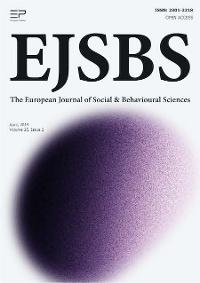Abstract
Changes in autonomic function which results from anxiety can lead to an urge to defecate or urinate. In some patients, an exaggeration in visceral sensations can be accompanied by obsession and catastrophic fears that the patient may imminently lose control of their bladder or bowel functioning. The condition, known as bowel/bladder control anxiety (henceforth BBCA) disorder can hurt the social quality of life. In this paper, a case of a woman with bowel/bladder control anxiety disorder is presented. The patient was treated using cognitive behavioral therapy (henceforth CBT) to manage her anxiety about the imminent loss of control of her bowel, which had pushed her to avoid traveling outside of her house. Treatment consisted of six sessions of CBT. At the end of the therapy, the patient reported increased confidence to go outside her home, suggesting that CBT could be useful in the management of bowel/bladder control anxiety disorders.
Keywords: Cognitive-Behavioral Therapy, Anxiety, Bowel/Bladder Control Anxiety
Objective
In some patients, an exaggeration in visceral sensations can be accompanied with obsession and catastrophic fears that the patient may imminently loss control of their bladder or bowel functioning, a condition known as bowel-and-bladder control anxiety (Pajak & Kamboj, 2014; Biedel & Bulik, 1990; Cosci, 2013; Kamboj, Langoff, Pajak, Zhu, Chevalier, & Watson, 2013). Patients with the disease tend to obsessively check for internal sensation and tend to have compulsive voiding behavior, as well as, an overwhelming fear that they can lose control of their bladder and bowel functioning (Pajak & Kamboj, 2014). Cognitive behavioral therapy has been reported as an effective intervention for a variety of psychiatric conditions (Kazantzis, Brownfield, Mosely, Usatoff, & Flighty, 2017; Abramowitz, 1996; Olatunji, Davis, Powers, & Smits, 2013; Greist et al., 2002; Rosa-Alcazar, Sanchez-Meca, Gomez-Conesa, & Main-Martinez, 2008). However, little has been done on the use of CBT to treat BBCA. This paper reports a case of a woman who was suffering from bowel/bladder control anxiety which was treated successfully with CBT.
Case Presentation
The client, a 29-year-old bank manager from Southern Europe suffering from compulsive BBCA, sought help from a psychological counseling center to lessen the time she spends in her house. She reported that one day while she was traveling with her friends, she experienced the urgent need to go to the toilet on the bus. She explained that she was frantic that she would ‘’defecate on herself’’. After the trip, this idea continued to disturb her mentally. She preferred to stay near the toilet just in case she feels the needed to defecate. The problem had affected her daily life, forcing her to remain indoors for over a month. She visited a hospital to check her bowel; the tests did not confirm any pathology. The client was diagnosed with BBCA, and CBT recommended as the treatment intervention.
Methods
CBT techniques were used in this case to correct and replace the client’s distorted thinking and dysfunctional beliefs with alternative healthier ones.
In total, the client participated in six 50-minute sessions throughout six weeks. Each session began and ended by evaluating her mood and response to the meeting, as well as assessing her progress using the Yale-Brown Obsessive-Compulsive Scale.
In the first session, the therapist informed the client about ethical principles and the limits of confidentiality and made sure that the client clearly understood her rights as a patient. Socratic questioning techniques were applied.
After assessing the client’s emotions and behaviors, the therapist described the relationship between emotions and practice using the ABC model. The ABC model allows the therapist to introduce a new perspective to the patient about the source of their pathology (David, Matu, Pintea, Cotet, & Nagy, 2014).
In the first two sessions, the client learned how to access her automatic thoughts according to her feelings, including recording her gut reaction during anxiety. Psycho-education was applied, as it allows a therapist to explain the source of pathology and the dynamics of the pathology (Donker, Griffiths, Cuijpers, & Christensen, 2009; Srivastava, & Panday, 2016). The Socratic questioning revealed that there was a missing part of how often she used the toilet in a day. At the end of the session, the client was given homework to monitor and write down her daily toilet routine
In the third session, the therapist checked the client’s homework to allow the therapist to gauge the extent to which the patient practiced and reinforced the skills the client had learned during the therapy sessions (Tang & Kreindler, 2017; Kazantzis et al., 2017). The client then acknowledged that her negative thoughts hurt her emotional state. She found that she actually only used the toilet once despite making ten visits, suggesting she could cut the visits from 10 to 1, but she still had a fear of leaving her home. In session four, the Socratic questioning and exercises were used to try to change the client’’s perception, and also identify errors in her thinking. At the end of the session, the client was taught breathing lessons to allow her to control her emotions in case of panic attacks.
In the fifth session, the client was requested to imagine a situation where she had defecated in her trousers outside the house and to write down the alternatives that she could use in such a situation. By imagining this scenario, the client was exposed to the situation where she experienced anxiety. During the sixth and final session, the client mentioned that the survey questions were instrumental in helping her to understand other people’s perspective apart from hers. At the end of the sessions, progress was evaluated using the Yale-Brown scale and a comparison of development with the defined goals.
Results and Discussion
While the patient harbored residual compulsive symptoms about going out, she felt confident that she would be able to leave the house and go back to her social life. During the follow-up review after six months, she reported that her social life was a success, and was continuing to use the techniques that she had learned during the sessions. The use of the ABC model to show how thoughts influence a person’s mood was particularly useful in motivating the client to evaluate the source of her fears. According to Beck (1976), the ABC theory posits that people do not think about alternative explanations when evaluating adverse effects. The most effective method of changing a misinterpretation is to help the individual to come up with an alternative and less threatening explanation of their experience, which can explain the effectiveness of CBT in managing the client’s condition (Oltean, Hyland, Vallieres, & David, 2017; Lam & Gale, 2000).
Conclusion
BBCA is considered a compulsive disorder characterized by a belief that a patient may lose control of their bowels or bladder (Pajak & Kamboj, 2014). In the current case, the client had experienced high levels of anxiety, owing to the firm belief that if she traveled away from her home, she would defecate on herself. She was diagnosed with BBCA, and CBT was recommended as an intervention. This instance is perhaps one of the first to apply CBT to a case of a client with BBCA. Other studies have employed different approaches such as imagery and pharmacological interventions (Pajak & Kamboj, 2014; Hatch, 1997; Porcelli & Leandro, 2007), thus providing evidence for the potential utility of CBT in the treatment of BBCA.
References
Abramowitz, J. (1996). Variants of Exposure and Response Prevention in the Treatment of Obsessive Compulsive Disorder: A Meta-Analysis. Behavior Therapy, 27(4), 583-600.
Beck, A. T. (1976). Cognitive therapy and emotional disorders. New York: International Universities Press.
Biedel, C., & Bulik, C. (1990). Flooding and Response Prevention as Treatment for Bowel Obsessions. Journal of Anxiety Disorders, 4(3), 247-256.
Cosci, F. (2013). Bowel Obsession Syndrome in a Patient with Chronic Constipation. General Hospital Psychiatry, 35(4), 1-3.
David, O., Matu, S., Pintea, S., Cotet, C., & Nagy, D. (2014). Cognitive-Behavioral Processes Based on Using the ABC Analysis by Trainees’ for Their Personal Development. Journal of Rational-Emotive & Cognitive-Behavior Therapy, 32(1), 198-215.
Donker, T., Griffiths, K., Cuijpers, P., & Christensen, H. (2009). Psychoeducation for Depression, Anxiety and Psychological Distress: A Meta-Analysis. BMC Med, 7(9), 1-9.
Greist, J., Marks, M., Baer, L., Kobak, K., Wenzel, K., Hirsch, M., . . . & Clary, C. (2002). Behaviour Therapy for Obsessive-Compulsive Disorder Guided by a Computer or by a Clinician compared with Relaxation as Control. The Journal of Clinical Psychiatry, 63(2), 138-145.
Hatch, M. (1997). Conceptualization and Treatment of Bowel Obsessions: Two Case Reports. Behaviour Research and Therapy, 35(3), 253-257.
Kamboj, S., Langoff, C., Pajak, R., Zhu, A., Chevalier, A., & Watson, S. (2013). Bowel and Bladder Control Anxiety: A Preliminary Description of Viscerally Centered Phobic Syndrome. Behavioral and Cognitive Psychotherapy, 19(1), 1-16.
Kazantzis, N., Brownfield, N., Mosely, L., Usatoff, A., & Flighty, A. (2017). Homework in Cognitive Behavioral Therapy: A Systematic Review of Adherence Assessment in Anxiety and Depression (2011-2016). The Psychiatric Clinics of North America, 40(4), 625-639.
Lam, D., & Gale, J. (2000). Cognitive Behaviour Therapy: Teaching a Client the ABC Model- The First Step Towards the Process of change. Journal of Advanced Nursing, 31(2), 444-451.
Olatunji, B., Davis, M., Powers, M., & Smits, J. (2013). Cognitive Behavioural Therapy for Obsessive Compulsive Disorder: A Meta-Analysis of Treatment Outcome and Moderators. Journal of Psychiatric Research, 47(1), 33-41.
Oltean, H., Hyland, P., Vallieres, F., & David, D. (2017). An Empirical Assessment of An Empirical Assessment of REBT Models of Psychopathology and Psychological Health in the Prediction of Anxiety and Depression Symptoms. Behavioural and Cognitive Psychotherapy, 45(6), 600-615.
Pajak, R., & Kamboj, S. (2014). Experimental Single Session Imagery Rescripting of Distressing Memories in Bowel/ Bladder Control Anxiety: A Case Series. Frontiers in Psychiatry, 5(182), 1-7.
Porcelli, P., & Leandro, G. (2007). Bowel Obsession Syndrome in a Patient with Ulcerative Colitis. Psychosomatics, 48(5), 448-450.
Rosa-Alcazar, A., Sanchez-Meca, J., Gomez-Conesa, A., & Main-Martinez, F. (2008). Psychological Treatment of Obsessive Compulsive Disorder: A Meta-Analysis. Clinical Psychology Review, 28(8), 1310-1315.
Srivastava, P., & Panday, R. (2016). Psychoeducation an Effective Tool as Treatment Modality of Mental Health. The International Journal of Indian Psychology, 4(1), 1-8.
Tang, W., & Kreindler, D. (2017). Supporting Homework Compliance in Cognitive Behavioural Therapy: Essential Features of Mobile Apps. JMIR Mental Health, 4(2).
Copyright information

This work is licensed under a Creative Commons Attribution-NonCommercial-NoDerivatives 4.0 International License.


